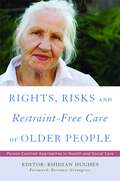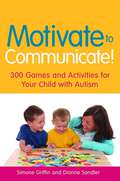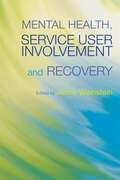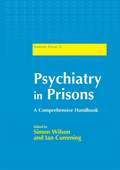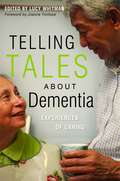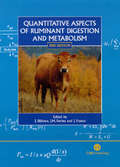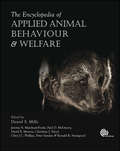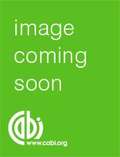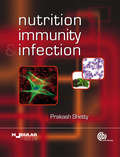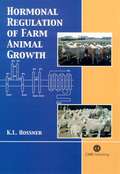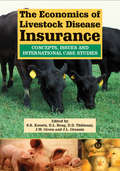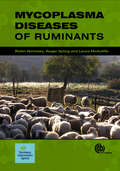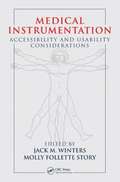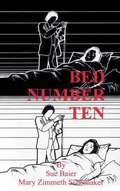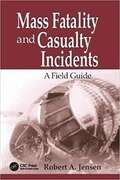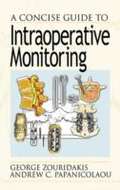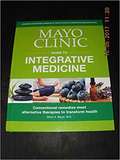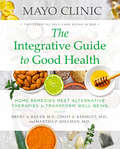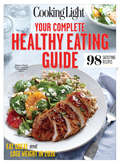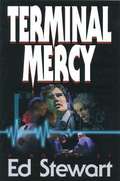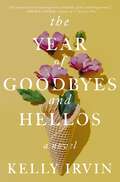- Table View
- List View
Rights, Risk and Restraint-Free Care of Older People
by Edited by Rhidian HughesThe restraint of older people is a pressing issue for health and social care practice. This book provides health and social care professionals with an authoritative reading resource on the ethics and use of restraint. The book provides an overview of the different forms of restraint, the conditions under which they are used, and their implications for the health and wellbeing of older people. Practical approaches to minimising are then explored, underlining the importance of person-centred care. Innovative programmes and approaches to reducing the use of restraint from around the world are described and assessed, and case studies are drawn upon to highlight practice challenges and their effective resolutions. The perspectives of older people and their carers and families, as well as of professionals, commissioners and regulators of health and social care, are also taken into account. The contributors are drawn from an international range of health and social care settings, as well as from the academic world. This in-depth volume will help health and social care professionals better understand the complex issues that surround the use of restraint, support practice that puts older people at the centre of decision-making about their care, and enable services to provide safer and more appropriate care.
Motivate to Communicate!
by Simone Griffin Dianne SandlerThis practical resource is brimming with exciting ideas and guidance for motivating children with autism and other communication difficulties. The clear, user-friendly format enables quick access to over 300 practical, fun-filled games and activities for developing your child's communication skills. The book suggests creative ways to use everyday toys and objects. For example, if your child likes to pop bubbles, perhaps he would also enjoy counting bubbles, catching bubbles on a wand, stomping them with his feet or even playing bubble volleyball! The innovative ideas in this book have been developed over 40 years of clinical and educational experience, and are designed to be fun for both the adult and the child. All resources mentioned in this book are readily available and can be used to advance communication skills at all levels, from reaching out for an item, to extending verbal communication. Motivate to Communicate! is perfect for supporting parents, care-givers and professionals in motivating and developing the communication skills of children on the autism spectrum.
Mental Health, Service User Involvement and Recovery
by Jenny WeinsteinAs the momentum for personalisation and recovery approaches grows, service users are increasingly participating as partners in all aspects of health and social care delivery, policy-making and professional training. This book provides an overview of service user involvement in mental health, its origins and current practice and policy. Written cooperatively by service users and academics, this book conveys a vital connection between recovery and involvement, offering a framework of values and helpful strategies to promote meaningful user participation. By sharing their personal narratives and contributing their views, service user authors demonstrate how taking control of their own care facilitates a swifter and more satisfying recovery. The book further acknowledges the bilateral value of user involvement in the development of mental health services, student learning, collaborative research and challenging social stigma, providing examples and critical appraisal of how this is currently being implemented. With a strong, positive emphasis on the benefits to all stakeholders, Service User Involvement and Recovery in Mental Health offers guidelines for good practice that will be relevant to health and social care practitioners, service users, students, researchers and educators.
Telling Tales About Dementia
by Edited by Lucy WhitmanHow does it feel when someone you love develops dementia? How do you cope with the shock, the stress and the grief? Can you be sure that you and your family will receive the support you need? In Telling Tales About Dementia, thirty carers from different backgrounds and in different circumstances share their experiences of caring for a parent, partner or friend with dementia. They speak from the heart about love and loss: 'I still find it hard to believe that Alzheimer's has happened to us,' writes one contributor, 'as if we were sent the wrong script. ' The stories told here vividly reflect the tragedy of dementia, the gravity of loss, and instances of unsatisfactory diagnosis, treatment and care. But they contain hope and optimism too: clear indications that the quality of people's lives can be enhanced by sensitive support services, by improved understanding of the impact of dementia, by recognising the importance of valuing us all as human beings, and by embracing and sustaining the connections between us. This unique collection of personal accounts will be an engaging read for anyone affected by dementia in a personal or professional context, including relatives of people with dementia, social workers, medical practitioners and care staff.
Quantitative Aspects of Ruminant Digestion and Metabolism (2nd edition)
by J. M. Forbes J. Dijkstra J. FranceA comprehensive review of the digestion and metabolism of ruminant animals. Since its publication, much new research has been conducted in the subject and knowledge has increased. This new edition includes Dr. Dijkstra as an additional editor and four completely new chapters. These cover: the gas production technique in feed evaluation; the relationship between pasture characteristics and animal performance; calorimetry; and feed processing. Other chapters have been expanded or updated as appropriate.
Encyclopedia of Applied Animal Behaviour and Welfare
by David Morton Peter Sandøe Jeremy Marchant-Forde Clive Phillips Christine Nicol Paul Mcgreevy Daniel Mills Ronald SwaisgoodWelfare research has established a range of scientific indicators of stress, welfare and suffering in animals that can be applied to all aspects of improving their welfare through good housing and management, and the topic continues to grow in importance among both professionals and the public. The practical focus of this authoritative, comprehensive encyclopedia aims to promote the understanding and improvement of animals' behaviour without compromising welfare. Under the editorial direction of Professor Daniel Mills, the UK's first specialist in veterinary behavioural medicine, over 180 international experts have contributed a wealth of fully cross-referenced entries from concise definitions to detailed short essays on biological, practical, clinical and ethical aspects of behaviour and welfare in domestic, exotic, companion and zoo animals.
Keys to the Trematoda, Volume 3
by David Gibson David Blair John Pearson Arlene Jones Stephane Deblock R Madhavi Tomas Scholz Diane Barton Thomas Cribb S Pozdnyakov T Pojmañska Vasyl Tkach Ronald Campbell William Font Jeffrey Lotz C Santos Rodney Bray Terrence MillerThis is the third of three volumes of Keys to the Trematoda, a series on the systematics and identification of the Class Trematoda. It covers five superfamilies with the Order Plagiorchiida and the family Didymozoidae, with the keys for their identification at the family, subfamily and generic levels. It also includes a key to all dignean superfamilies, including those treated in detail in volumes oneand two.
Nutrition, Immunity and Infections
by Prakash ShettyInfectious diseases are an important cause of malnutrition. Recurrent infections increase the risk of malnutrition while poor nutritional status results in lowered immune status and predisposes to infectious disease thus propagating the vicious cycle of infection and malnutrition. The nutrition-infection-immunity axis is crucial for both developed and developing countries and is now a central feature of many nutrition and infectious disease courses. Bringing together nutrition and immunology, Nutrition, Immunity and Infections covers the topic in an accessible format for all students of nutrition, medicine and public health. Through his work at the London School of Hygiene and Tropical Medicine, the FAO's Food and Nutrition Division and his current post at the University of Southampton, Professor Shetty has built a reputation to match his wealth of experience in the relationship between nutrition and susceptibility to infection.
Nutrition, Immunity and Infection
by Prakash ShettyInfectious diseases are an important cause of malnutrition. Recurrent infections increase the risk of malnutrition while poor nutritional status results in lowered immune status and predisposes to infectious disease thus propagating the vicious cycle of infection and malnutrition. The nutrition-infection-immunity axis is crucial for both developed and developing countries and is now a central feature of many nutrition and infectious disease courses. Bringing together nutrition and immunology, Nutrition, Immunity and Infections covers the topic in an accessible format for all students of nutrition, medicine and public health. Through his work at the London School of Hygiene and Tropical Medicine, the FAO's Food and Nutrition Division and his current post at the University of Southampton, Professor Shetty has built a reputation to match his wealth of experience in the relationship between nutrition and susceptibility to infection.
Hormonal Regulation of Farm Animal Growth
by K. L. HossnerHossner (animal sciences, Colorado State U.) describes the regulation of farm animal growth by hormones and growth factors. The focus is on developmental, cellular, and molecular mechanisms regulating the growth and differentiation of skeletal muscle, bone, and adipose tissue. Suitable for advanced undergraduate and graduate animal science courses, the text assumes some background knowledge of biochemistry and cell biology. Annotation ©2006 Book News, Inc., Portland, OR (book news.com)
The Economics of Livestock Disease Insurance: Concepts, Issues and International Case Studies
by Stephen R. Koontz J. L. Grannis D. L. Hoag D. D. Thilmany J. W. GreeneThe collection of studies emerged from two conferences. One in Fort Collins, Colorado in November 2002 invited professionals from countries where livestock disease insurance is common to share their experience on the matter with American insurance professionals. The other, in July 2003 in Denver, focused primarily on the US. The information is intended to be useful primarily to government agents, the insurance industry, and academics in agricultural economics. The 20 papers explore how to build a livestock insurance program, look at the international marketplace, and present case studies. Annotation ©2006 Book News, Inc., Portland, OR (book news. com)
Mycoplasma Diseases of Ruminants
by Robin Nicholas Roger Ayling Laura McauliffeMycoplasmas are the smallest of free-living organisms and are intermediate between viruses and bacteria. Many species thrive as parasites in animal (including human) hosts. This book is based on proceedings of a conference held in Palermo, Italy. It reviews some of the most important mycoplasma diseases of sheep, goats and cattle including contagious bovine pleuropneumonia, contagious agalactia and calf pneumonia, which are listed by the OIE because of their economic implications.
Medical Instrumentation Accessibility and Usability Considerations
by Jack M. Winters Molly Follette StoryIntegrating expert perspectives from a wide array of disciplines, Medical Instrumentation traces a clear roadmap for improving accessibility and usability for a variety of stakeholders and provides the tools necessary to follow it.
Bed Number Ten
by Sue Baier Mary Zimmeth SchomakerA patient's personal view of long term care. Seen through the eyes of a patient totally paralyzed with Guillain-Barre syndrome, this moving book takes you through the psychological and physical pain of an eleven month hospital stay. BED NUMBER TEN reads like a compelling novel, but is entirely factual. You will meet: The ICU staff who learned to communicate with the paralyzed woman - and those who did not bother. The physicians whose visits left her baffled about her own case. The staff and physicians who spoke to her and others who did not recognize her presence. The nurse who tucked Sue tightly under the covers, unaware that she was soaking with perspiration. The nurse who took the time to feed her drop by drop, as she slowly learned how to swallow again. The physical therapist who could read her eyes and spurred her on to move again as if the battle were his own. In these pages, which reveal the caring, the heroism, and the insensitivity sometimes found in the health care fields, you may even meet people you know.
Mass Fatality and Casualty Incidents: A Field Guide
by Robert A. JensenMass Fatality and Casualty Incidents: A Field Guide presents in checklist form the recommended responses to events that result in mass fatalities, such as the Oklahoma City bombing, the crash of a jet airliner, or the attack on the World Trade Center. All cities in the United States will have to have a mass fatality disaster plan in effect by the end of 1999. Mr. Jensen is a leading authority in this area and provides training for police, fire and hospital personnel (including EMTs and social workers), local, state, federal and international emergency planners and responders. This book details actions that are part of a mass fatality incident response. Specifically, they are the actions that begin once life and property preservation ceases and continues through to the release of the deceased. Thus, primary focus is on search, recovery, medicolegal investigation, personal effects operations, family assistance operations, and media operations. Ancillary steps include logistics support, security, responder protection, attitudes and coping with mass death.
A Concise Guide To Intraoperative Monitoring
by George Zouridakis Andrew PapanicolaouCovering both the applications and the related theory, A Concise Guide to Intraoperative Monitoring provides a general but comprehensive introduction to IOM. Unlike existing texts that typically report the results of specific studies, this book presents comprehensive coverage of the entire procedure, as well as the specific protocols used in hospital practice, examples of typical recordings, possible problems, and recommended solutions. At the end of each chapter the author poses several questions for review. These questions help technologists and medical residents in their preparation for the board exams. Taken together, these features make the book an ideal reference or training manual. <p><p> A Concise Guide to Intraoperative Monitoring begins by discussing the basic principles underlying the generation of bioelectrical signals. It then describes the electronic equipment and the various electrophysiological procedures involved in IOM. From this foundation, the book gradually advances to more specific topics, such as surgical procedures, neuronal structures at risk, the optimum combinations of tests to administer, and the proper interpretation of test results. The material also provides you with a background on general anesthesia and analyzes the effects of various drugs on electrophysiological recordings. A Concise Guide to Intraoperative Monitoring also discusses the proper placement of stimulation and recording electrodes, as well as intervention strategies and equipment troubleshooting.
Mayo Clinic Guide to Integrative Medicine: Conventional Remedies Meet Alternative Therapies to Transform Health
by Brent A. Bauer Mayo Clinic Staff Stewart J. Koski Kent McDaniel Matthew C. Meyer Gunnar T. Soroos Malgorzata B. WeivodaMAYO CLINIC Guide To INTEGRATIVE MEDICINE
Mayo Clinic: Home Remedies Meet Alternative Therapies to Transform Well-Being
by Brent A. Bauer Cindy A. Kermott Martha P. MillmanThis compendium on healthy living from the trusted Mayo Clinic organization combines two home health books into one must-have resource. Anyone looking to improve health in a safe, smart, innovative, and minimally-invasive way will want this guide. The book teaches what integrative medicine is,the medical movement to incorporate treatments that were once thought questionable but now are scientifically proven to work into everyday therapies, combining those alternative methods with traditional medicine to produce best results. The book offers a revolutionary approach to healing by highlighting ways that integrative medicine addresses not only the physical body but also the mind and spirit. With this trifold view of wellness in mind, the book covers topics like meditation, homeopathy, acupuncture, reflexology, herbs and supplements, and more, giving readers new solutions to their health issues.
COOKING LIGHT 300 Calorie Main Dishes: Delicious Everyday Meals
by The Editors of Cooking LightMaintaining a healthy weight or trying to lose a few pounds ultimately revolves around the science of counting calories. ItÍs a tedious task to tabulate every morsel you put in your mouth, but thereÍs a simpler and much more flexible strategy: Start a file of skinny recipes. We think our 300-calorie main dishes are the perfect indulgence for the conscientious, gourmand weight watcher.Taste always comes first in our 195 top-rated recipes and tips included in our 300-Calorie Main Dishes bookazine. Whether you need fresh breakfast ideas, satisfying lunches, or easy family dinners, weÍve got a delicious meal in mind. For breakfast, we can suggest making a Spanish potato and spinach tortilla with Red Pepper Sauce. Lunch could be shrimp tacos with green apple salsa, followed by a dinner of pork medallions with whisky-Cumberland sauce and haricots verts. Sometimes, one lower-calorie meal a day is all you need to get back on track; let us help you in the most delectable way.
COOKING LIGHT Your Complete Healthy Eating Guide: Eat Great and Lose Weight in 2016
by The Editors of Cooking LightNew Year, New You - or, at least that's what you tell yourself each year. After trying the latest diet trend, you give up after a month and you're back to ground zero. The solution is not another diet, but rather a guide to eating healthier. Cut the calories without cutting the flavor with satisfying recipes that will help you look and feel better.Brought to you by the editors of Cooking Light, Your Complete Healthy Eating Guide features 98 satisfying recipes that will help you eat great and lose weight. Cooking Light is committed to helping you achieve healthier eating habits and provides with you fun, fast, and budget-friendly recipes. Some of our favorites include Everyday Frittata, Sweet Potato Gnocchi with Bacon and Sage, Balsamic and Dijon-Glazed Chicken Breasts, Roasted Garlic Mac and Cheese, and Quick Banana and Milk Chocolate S'mores. Lead a healthy and balanced lifestyle by reducing saturated fats, sodium, and caloric intake while increasing fruit and vegetable intake. Embrace a balanced diet, eat clean, and at the end of the day, you will have not only conquering your New Year's Resolution, but you'll feel great, too.
Terminal Mercy
by Edward StewartDr. Jordan Keyes fights to save his patients, his career, and his own life as he becomes entangled in a web of deceit, genetic testing, and murder. Jordan must also fight the forces within himself to become the husband his wife deserves in order to save his marriage. this book is a contemporary medical thriller.
52 Ways to Prevent Heart Disease
by J. Mitchell Miller Terry T. Shintani52 suggestions to help prevent heart disease.
Ten Fingers for God: The Complete Biography of Dr. Paul Brand
by Dorothy C. WilsonTen Fingers for God describes the extraordinary servanthood--the life of Dr. Paul Brand, a medical doctor, whose life and work have been a blessing to countless thousands of leprosy victims on five continents. Through surgeries (over 3,000 in India alone), the pioneering research he has conducted and inspired, and his empathy for the poor and forsaken. Dr. Brand has achieved fame in the medical world. Dr. Brand's professional life has centered on perhaps the most problematic aspect of creation, the existence of pain. His conviction that the function of pain in the human body is a disguised blessing to the human race. He felt that "God designed the human body so that it is able to survive because of pain. As a surgeon, teacher, and environmentalist. Dr. Brand 'has chosen the middle way of balancing the material and the mystical, the prophetic and the pragmatic. His spirit of self-sacrifice and humility can best be distilled by his sureness that "it is a pity that a man has only one life to spend, one pair of feet, two hands, ten fingers! Paul Brand is an adventure loving, highly spiritual surgeon who discovers his life's calling is to improve the hands and feet of people with leprosy worldwide. He developed techniques for returning functionality to disfigured, numb hands and feet and goes on to establish centers where patients receive protective shoes and learn skills to become employable. Paul both teaches others in many countries to help in his mission and learns from other doctors, scientists and rehabilitation specialists. In his travels and impassioned, informative speeches he raises awareness of this disease which is only contagious for a brief time and inspires people to pool their resources to improve care for a population ending their generations old fate of being shunned, ostracized and forced to beg for their survival.
The Year of Goodbyes and Hellos
by Kelly IrvinTwo sisters seek a new balance in work, family, and love when one receives a diagnosis that sets the clock ticking.Determined to save Sherri&’s life, Kristen drops everything to guide her sister on the harrowing cancer treatment journey. When she&’s unable to balance the strain of caring for her patients, being a wife and mother, and her frantic efforts to save her sister, Kristen&’s carefully balanced life crumbles, starting with her marriage. Desperate to regain her footing, she vows to rebuild her broken relationships . . . as soon as she&’s sure Sherri will beat the odds stacked against her.Unlike her sister, Sherri Reynolds has worked to cultivate balance in her life. Her children, her job as a teacher, and her strong faith keep her grounded—until her diagnosis sends her spiraling into the scary world of what-ifs and unknown outcomes. Sherri faces the agonizing realization that family history may be about to repeat itself. With the clock ticking, she&’s determined to use whatever time she has left to heal old wounds and restore relationships.Poignant contemporary Christian fictionStand-alone novelBook length: 113,000 wordsIncludes discussion questions for book clubs
